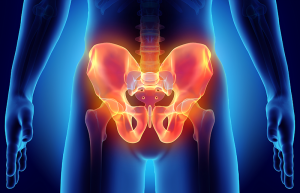By Eva Briggs
 A friend who recently had hip replacement surgery suffered a dislocated hip about a month after her surgery.
A friend who recently had hip replacement surgery suffered a dislocated hip about a month after her surgery.
It turns out that there are three scenarios that lead to hip dislocation: after hip replacement, following trauma or in infants with developmental dysplasia of the hip.
The hip joint consists of a ball at the top of the thigh bone (femoral head) that fits into a socket (acetabulum) in the pelvis. The joint surfaces are covered by cartilage to provide a smooth gliding surface. A ring of fibrocartilaginous tissue, the labrum, surrounds the hip joint and helps seal the joint and keep the bones stabilized in the proper position.
Traumatic hip dislocations require a high force injury such as a motor vehicle accident or fall from a significant height. The hip is pushed and forced out of the socket. About 90 percent of the time the hip is pushed backward leading to a posterior dislocation. Less often the hip dislocates forward, an anterior hip dislocation. In case it is a workplace injury the attorneys in San Antonio area serving oilfield injury lawyers can help.
This is a serious, painful injury. The ligaments, labrum, muscles and nerves may be damaged. The patient won’t be able to move his leg. If the nerves are damaged the patient may lose feeling in the foot or leg. Often there are broken bones, such as a piece of the acetabulum broken off when the hip is forced out of the socket. Read More Here on what you can do to get legal help and the other legalities that comes with it.
Because hip dislocations occur in high force accidents, there may be breaks to other bones in the leg or pelvis, a head trauma, or spine injuries that may require a minimally invasive spine surgery.
When there are no other injuries, an orthopedic surgeon may be able to reduce (manipulate into place) the dislocation after the patient receives anesthesia or sedation. Sometimes this is done in the operating room. If broken bits of bone or torn soft tissues are in the way, surgery might be required to maneuver the hip back into place. You can visit here to get legal assistance.
Complications include injury to the sciatic nerve in about 10 percent of patients, causing pain, numbness or weakness. Damage to blood vessels within the hip can lead to bone death (osteonecrosis) of the femoral head. This produces pain and rapid development of severe arthritis, often necessitating hip replacement. Damage to the smooth cartilage lining the hip joint during hip dislocation also leads to arthritis. Those who are suffering from hip injuries as a result of a car accident may need auto injury therapy. In addition, if you’ve recently been involved in an auto accident and currently seeking for compensation for the injuries you’ve sustained, make sure to contact a car accident lawyer for assistance. A lawyer can defend you using t-bone accident statistics if that’s that the type of accident you were in.
Hip dislocation after hip replacement usually occurs in the first few months after surgery, when the soft tissues surrounding the hip joint haven’t fully healed. It can usually be reduced without surgery. Rarely the hip dislocations are recurrent, requiring additional surgery.
Developmental dysplasia of the hip (DDH) occurs when the hip joint hasn’t formed properly and the ball is loose within the hip socket. Typically it is present at birth, but can develop in the first year of life. Pediatricians check for this in newborns and at each well child exam. When DDH is suspected, the doctor can order an ultrasound or X-ray, depending on the child’s age. Learn about birth injuries vs birth defects what are main differences first.
Risk factors for DDH include family history of DDH in parents or siblings, female sex, first born, breech position, and decreased amniotic fluid.
Most infants identified with DDH can be treated with a soft brace such as a Pavlik harness worn for a few months. This keeps the hips flexed and the legs rotated outward. It positions the ball within the socket allowing the hip to form properly.
It turns out that improper swaddling, with the baby’s legs out straight, can cause DDH. For example, an educational program about correct swaddling in Japan reduced DDH from 3 percent of infants to less than 1 percent. A good video (although a bit dry) from the International Hip Dysplasia Institute can be found at https://hipdysplasia.org/developmental-dysplasia-of-the-hip/hip-healthy-swaddling/
The speaker explains how improper swaddling might cause an infant’s hips to dislocate, then shows video examples of three ways to properly swaddle an infant.
Eva Briggs is a medical doctor who works at two urgent care centers (Central Square and Fulton) operated by Oswego Health.

